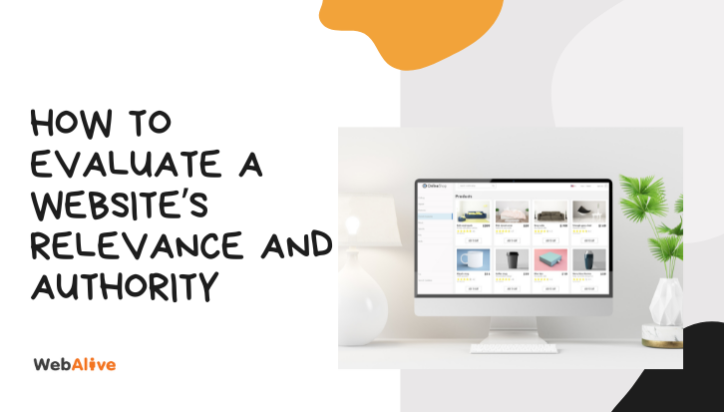
How to Evaluate a Website’s Relevance and Authority
It’s no secret that in the hyper-online world we live in now, the quality of your online connections matters more than ever. Whether you’re looking to build partnerships, expand your digital presence, or develop an effective marketing strategy, knowing how to evaluate a website’s relevance and authority is crucial.
This comprehensive guide will walk you through the essential steps to assess any website’s credibility and relevance to your business objectives.
1. Understanding content relevance and alignment
Topic relevance assessment
The foundation of any meaningful digital relationship begins with content alignment. When evaluating a website, the first step is to assess its content topics and themes thoroughly. This goes beyond simply scanning headlines—it requires a deep dive into their content strategy and editorial focus.
Start by examining their recent articles, blog posts, and permanent content pages.
Ask yourself:
- Does the website consistently cover topics that align with your industry sector?
- Are the discussions relevant to your target audience’s interests and needs?
- Does the content demonstrate expertise in areas that complement your business offerings?
For instance, if you’re in the financial technology sector, a website focusing on general technology news might be relevant, but one specialising in fintech innovations and banking technology would be even more valuable.
Content appropriateness and brand safety
Equally important is ensuring the website’s content aligns with your brand values and reputation management goals.
This evaluation should consider:
- The overall tone and professionalism of the content.
- Any controversial topics or stances the website might take.
- The presence of potentially harmful or inappropriate content.
- The website’s advertising practices and partner associations.
Remember, every digital association can impact your brand’s reputation. A website might have excellent metrics but could damage your brand if it publishes controversial content or associates with questionable entities.

2. Analysing website statistics and performance
Understanding domain metrics
Statistical analysis can provide some concrete data about a website’s authority and reach. You can often skip some of this research to a third party like a link building agency, they will do this research for you, but it’s still a good idea to be across the basics.
Key metrics to examine include:
Domain Authority (DA): A predictive ranking score developed by SEO software company Moz that can tell you how far up in the results your website is going to rank in a query. It is generally considered to be quite a reliable indicator of optimisation performance.
Domain Rating (DR): A metric developed by software company Ahrefs that measures the strength of a website compared to others in a database. It is measured on a 100-point scale.
Trust Flow and Citation Flow: It is an indicator of backlink strength and quality made by link checking site Majestic.
Website Age: How long the domain has been active.
Organic Traffic Trends: Monthly visitor statistics and growth patterns.
These metrics should be evaluated collectively rather than in isolation. A newer website might have lower domain authority but show strong growth trends and quality content. Using multiple metrics and understanding them as a whole will paint a clearer, more coherent picture.
Utilising professional tools
Professional SEO and analytics tools are essential for gathering comprehensive website data.
Popular platforms include:
SEMrush: Excellent for competitive analysis and traffic insights.
Moz Pro: Provides detailed domain authority metrics and keyword rankings.
Ahrefs: Offers comprehensive backlink analysis and domain ratings.
Similar Web: Provides traffic analysis and audience demographics.
Each tool offers unique insights, and using multiple platforms can provide a more complete picture of a website’s performance.

3. Evaluating editorial quality and objectivity
Content analysis
Objective content evaluation requires careful reading and analysis.
Look for:
- Balance in reporting and discussion.
- Proper citation of sources and data.
- A clear distinction between factual reporting and opinion.
- Transparency about sponsored content or affiliate relationships.
High-quality websites maintain editorial independence and clearly disclose any commercial relationships that might influence their content. This transparency improves trust and brand loyalty.
Writer credibility
Assess the expertise and credibility of the website’s content creators by:
- Reading author biographies and credentials.
- Checking their publication history.
- Evaluating their expertise in the subject matter.
- Looking for signs of bias or agenda-driven content.
Professional websites typically have established editorial guidelines and maintain consistent quality across all content. You don’t want your links to appear on a website that would publish just about anything.
4. Examining backlink profiles
Quality of backlink sources
A website’s backlink profile reveals much about its authority and networking practices.
Look for:
- Diversity in referring domains.
- Authority of linking websites.
- Relevance of linking content.
- Natural link growth patterns.
- A low percentage of spammy or low-quality links.
Using backlink analysis tools
Comprehensive backlink analysis requires sophisticated tools:
Majestic: Provides detailed Trust Flow and Citation Flow metrics.
Moz Link Explorer: Offers insights into linking domains and anchor text.
Ahrefs Backlink Checker: Shows detailed backlink history and quality metrics.
These tools can help identify red flags, such as sudden spikes in low-quality links or over-optimised anchor text patterns. No one likes being sold to; avoiding these obvious hiccups can improve authenticity and trust.
5. Assessing user experience and technical quality
Website design and navigation
A professional website should offer an excellent user experience. Having a laggy and unresponsive experience can negatively polarise your audience. Make sure you look through the website for the following:
- Clean, intuitive navigation.
- Fast loading times.
- Mobile responsiveness.
- Clear information architecture.
- Professional design aesthetics.
Technical health indicators
Technical excellence is crucial for website authority. Having your backlinks on a website that is poorly optimised and not secure can quickly erode consumer trust. Make sure the websites you choose have high technical health and secure certificates.
Evaluate:
- SSL certification and security measures.
- Site speed and performance.
- Mobile optimisation.
- Proper implementation of structured data.
- Clean URL structure and site architecture.
Poor technical implementation often indicates a lack of investment in quality and user experience.
Wrapping up
Evaluating a website’s relevance and authority requires a multi-faceted approach, considering content quality, technical performance, and statistical metrics. While tools and data provide valuable insights, human judgment remains crucial in assessing the overall fit for your business objectives.
Remember that website evaluation is not a one-time task but an ongoing process. Regular reassessment ensures your digital partnerships continue to align with your business goals and maintain the quality standards your brand deserves.
You read a lot. We like that
Want to take your online business to the next level? Get the tips and insights that matter.

